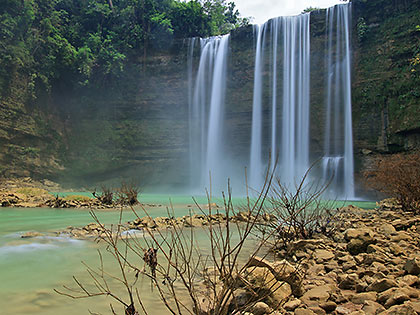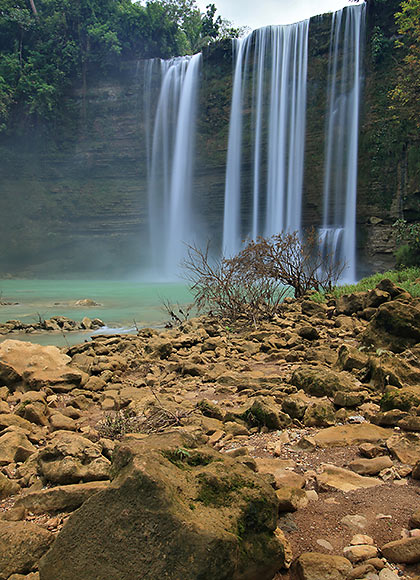Chasing Waterfalls in Negros Oriental
On a recent trip to Dumaguete in Negros Oriental – part of Nina's reunion and time together with her high school classmates – we were debating whether to visit Apo Island or make a return trip to Siquijor. We finally decided against it due to the rough seas and the cloudy skies. Instead we thought that this would be a good time to finally visit two waterfalls that have been hanging on our tour radars the past few years – the Niludhan Falls in Bayawan City and the Pulangbato Falls in Valencia.
Niludhan Falls
Niludhan Falls used to be a difficult trip due to the bad state of the roads especially that between Mabinay and Bayawan City. However, the latter road is now paved for the most part, with some small sections undergoing repair or concreting. The trip still took us around 3 hours coming from Dumaguete City proper but we deemed the time well worth it.
The falls are just a short walk from the main road and there is a concreted stairway leading down to the falls – a relief for our knees that have seen years of abuse from traveling. Some trees were blocking what would have been an excellent view of Niludhan from the side road but once we were down at the stream we could see all of Niludhan's magnificent 25 by 40 meters drop.
It was a windy day and the waterfall kept spraying us with mist whenever the wind would blow in our direction. It was difficult to shoot long exposure pictures of Niludhan in this condition or to get close to the waterfall for a different frame. Fortunately we had an umbrella with us that we used to shield ourselves and the camera equipment in between sprays of misty water. After about an hour of shooting and enjoying the spectacle we decided to head back to Dumaguete.
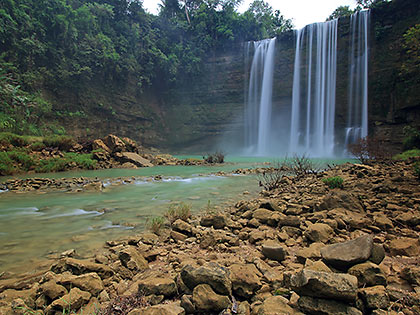
How to Get There
There are two ways to get to Niludhan if coming from Dumaguete: through Bayawan City or through Mabinay. (Niludhan Falls is actually within Barangay Dawis in Bayawan City.)
The Bayawan Route: If you're taking this route, take a Bayawan City-bound bus at the Ceres terminal near Robinsons Place mall. This trip takes around 2.5-3 hours. At Bayawan, hop on another bus bound for Mabinay and asked to be dropped off at Niludhan Falls which is just a short walk from the main road. Most of the buses plying the second leg of this route are probably non-AC.
The Mabinay Route: Although part of Bayawan, Niludhan Falls is actually closer to Mabinay. We chose the Mabinay route because it is the shorter one – about 100 km. vs. almost 140 km. for the Bayawan route. Take a Mabinay-bound Ceres bus from Dumaguete and asked to be dropped off at Paniabonan Junction or Crossing. The trip will take about 2.5 hours. At Panabionan you can either take a bus going to Bayawan – which will pass by Niludhan Falls on the way – or take a habal-habal. Buses aren't very frequent on this route so we took the habal-habals to save time. The ride took about 30 minutes.
It is best to leave Dumaguete early in the morning so you won't have problems with getting a ride back to the city. It's also best to bring along water and food for the trip although we did get to eat lunch at one of the many eateries at Paniabonan Junction.
Pulangbato Falls
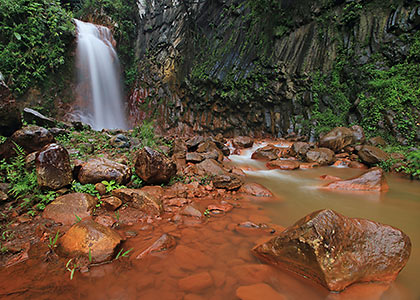
Pulangbato Falls: the red rock falls
Compared to the trip to Niludhan Falls, the one to Pulangbato Falls in Valencia is much shorter – about one hour or so from Dumaguete proper. An alternative is the more popular Casaroro Falls but we balked at climbing the 350 steps leading to the falls since we were still recovering from colds and coughs.
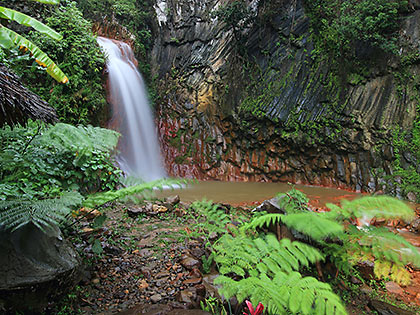
Interesting rock formations at Pulangbato Falls
Pulangbato got its name from the rust or reddish color of the rocks lying around the catch basin and the stream leading from the falls. Sulfuric fumes from geothermal activity in the area is the most obvious reason for this unusual coloration. There are many signs of such activity in the area – a hot springs resort nearby (the Red Rock Hot Springs Resort), vapors emanating from the rock formations on the side of the road leading to Pulangbato and a geothermal plant constructed in Valencia to take advantage of the geothermal activity.
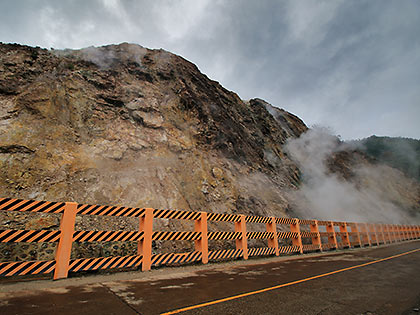
Sulfuric vapors escaping from fissure in the rocks on
the road to Pulangbato Falls
It was raining off and on when we got here but it didn't stop us from enjoying the place. The red rocks and thundering falls are the stars of the show but the interesting rock formations and surrounding verdant vegetation all served to add to the beauty and tranquility of the whole scene.
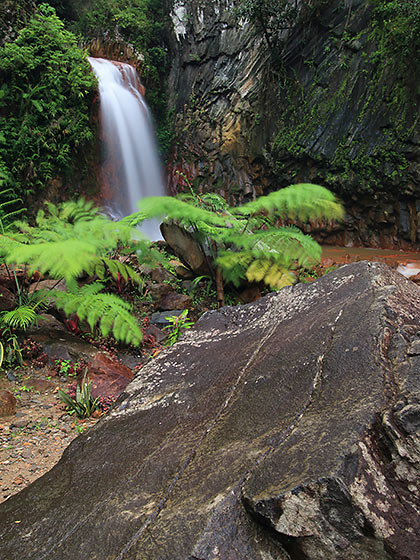
Rocks and greens, Pulangbato Falls
There are actually 3 waterfalls in the vicinity. Besides Pulangbato Falls there is a smaller waterfall near the entrance to Pulangbato and just a very short walk away. A third one is located on the hill farther up but it was too dangerous to access due to the very slippery slopes.
How to Get There
At Dumaguete look for jeepneys going to Valencia proper. Travel time for the jeepney ride is around 20-25 minutes from the area around Rizal Blvd. at P12 per person. The terminus of this jeepney ride is at a spot in Valencia town proper where habal-habals and trikes are waiting to bring you to Pulangbato Falls (and other attractions in town including Casaroro Falls) and back.
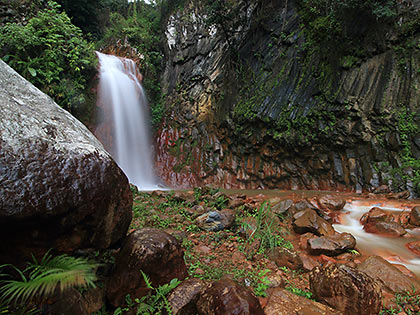
The second part of the trip by trike or habal-habal usually takes
30 minutes. In our case we took a trike for P450 (good for 2 people). You'll
enjoy the scenery along the way including the forested hills and river plus
the smoking rocks earlier mentioned.
Visit
us on Flickr

More Philippine destinations:
